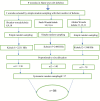Parental traditional medicine use for children and associated factors in Harar City, Harari Regional State, Eastern Ethiopia: a community-based cross-sectional study
- PMID: 40551777
- PMCID: PMC12183208
- DOI: 10.3389/fped.2025.1546455
Parental traditional medicine use for children and associated factors in Harar City, Harari Regional State, Eastern Ethiopia: a community-based cross-sectional study
Abstract
Introduction: Globally, there is consensus that traditional medicine (TM) has its benefit in solving health-related issues; however, a challenge lies in the lack of standardized scientific criteria to guide its appropriate use. Evidence suggests that, in some cases, traditional medicine may exacerbate health problems and lead to complications. Although many studies have explored traditional medicine use among adults, there is limited research on parental use of traditional medicine for children, particularly in Harar City. Therefore, the aim of this study was to determine the prevalence and associated factors of parental traditional medicine use for children in Harar City, Eastern Ethiopia.
Research methods: A cross-sectional study was carried out in the community of Harar City between 15 October and 15 November 2024. A multistage sampling procedure was used to obtain 348 parents. The required data were assembled through in-person interviews. The data that assembled were analyzed using Stata statistical software, version 16.0. To determine the associated factors with the outcome variable, multivariable logistic regression was applied via adjusted odds ratio (aOR) with a 95% confidence interval (CI). Independent variables with p < 0.05 were declared as significantly associated variables with the outcome variable.
Results: Approximately 348 parents were sampled for the study with a response rate of 100%. The proportion of parental TM use for children was 76.15% (95% CI: 71.8-80.5). Parents with more than four children (aOR = 3.24, 95% CI: 1.13-9.28), with a good attitude toward TM (aOR = 1.98, 95% CI: 1.02-3.86), and who were members of community-based health insurance (aOR = 0.34, 95% CI: 0.19-0.63) were independent variables associated with parental traditional medicine use for children.
Conclusion: Approximately three-quarters of parents reported using traditional medicine for their children. This practice was influenced by modifiable factors. Therefore, stakeholders in the health sector should give focused attention to the key factors influencing parental use of traditional medicine for children.
Keywords: Ethiopia; Harar; children; parental; traditional medicine.
© 2025 Alemu, Meseret, Keneni, Wondimneh, Legesse, Mossie, Teshager, Tamiru, Tizau and Asfaw.
Conflict of interest statement
The authors declare that the research was conducted in the absence of any commercial or financial relationships that could be construed as a potential conflict of interest.
Figures
Similar articles
-
Home treatment for mental health problems: a systematic review.Health Technol Assess. 2001;5(15):1-139. doi: 10.3310/hta5150. Health Technol Assess. 2001. PMID: 11532236
-
Cost-effectiveness of using prognostic information to select women with breast cancer for adjuvant systemic therapy.Health Technol Assess. 2006 Sep;10(34):iii-iv, ix-xi, 1-204. doi: 10.3310/hta10340. Health Technol Assess. 2006. PMID: 16959170
-
Prevalence and determinants of metabolic syndrome among adults living with HIV on first-line antiretroviral treatment in southern Ethiopia: a cross-sectional study.Ther Adv Chronic Dis. 2025 Jun 21;16:20406223251346289. doi: 10.1177/20406223251346289. eCollection 2025. Ther Adv Chronic Dis. 2025. PMID: 40546308 Free PMC article.
-
Drug management for acute tonic-clonic convulsions including convulsive status epilepticus in children.Cochrane Database Syst Rev. 2018 Jan 10;1(1):CD001905. doi: 10.1002/14651858.CD001905.pub3. Cochrane Database Syst Rev. 2018. PMID: 29320603 Free PMC article.
-
Behavioral interventions to reduce risk for sexual transmission of HIV among men who have sex with men.Cochrane Database Syst Rev. 2008 Jul 16;(3):CD001230. doi: 10.1002/14651858.CD001230.pub2. Cochrane Database Syst Rev. 2008. PMID: 18646068
References
-
- Kassaye KD, Amberbir A, Getachew B, Mussema Y. A historical overview of traditional medicine practices and policy in Ethiopia. Ethiop J Health Dev. (2006) 20(2):127–34. 10.4314/ejhd.v20i2.10023 - DOI
LinkOut - more resources
Full Text Sources


